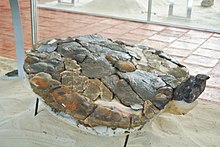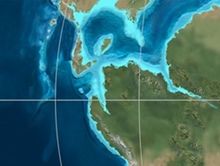Leyvachelys
| Leyvachelys | |
|---|---|

| |
| Scientific classification | |
| Domain: | Eukaryota |
| Kingdom: | Animalia |
| Phylum: | Chordata |
| Class: | Reptilia |
| Clade: | Pantestudines |
| Clade: | Testudinata |
| Clade: | †Thalassochelydia |
| Family: | †Sandownidae |
| Genus: | †Leyvachelys Cadena, 2015 |
| Species: | †L. cipadi
|
| Binomial name | |
| †Leyvachelys cipadi Cadena, 2015
| |

| |
| Paleogeography of Northern South America 120 Ma, by Ron Blakey | |
| Synonyms | |
| |
Leyvachelys is an extinct
, after which the genus is named. The holotype specimen is the oldest and most complete sandownid turtle found to date.Fossils of a turtle found in the
Etymology
The genus name is derived from Villa de Leyva and chelys means "turtle" in Greek. The species epithet cipadi refers to the CIP; the Centro de Investigaciones Paleontológicas, the paleontological research centre outside Villa de Leyva.[1]
Description
The
The turtle is the earliest recorded sandownid turtle in the world and the first of this family discovered in South America. The fossil find consists of a fairly complete skull, a well-preserved lower jaw and postcrania with an almost complete carapace, three cervical vertebrae, right humerus and coracoid, both femora, tibiae, and pelvic girdle. The length of the skull is estimated at 15.6 centimetres (6.1 in) and the maximum size of the carapace has been reported as 88 by 108 centimetres (35 by 43 in). The carapace of L. cipadi is the first complete ever found for a sandownid.[1]
Habitat

The
Fossil turtle fragments, initially and informally described as Glenrosechelys brooksi, found in the contemporaneous to slightly younger Glen Rose Formation of Texas have been assigned to the same genus Leyvachelys. Both occurrences in Texas (paleocoordinates 30.0° N, 55.5° W),[5] and Colombia (paleocoordinates 3.6° N, 42.2° W)[6] represent the northern and southern paleocoastline of the Early Cretaceous proto-Caribbean Sea.[1]
See also
- Carbonemys
- Desmatochelys padillai
- Cerrejón Formation
- Honda Group
- Fernando Etayo
- María Páramo
References
- ^ a b c d e f Cadena, 2015a
- ^ Cadena & Parham, 2015b, p.1
- ^ Kabakadze & Hoedemaeker, 1997
- ^ Bermúdez et al., 2013
- ^ SMU 246 at Fossilworks.org
- ^ Loma La Catalina at Fossilworks.org
Bibliography
- Bermúdez, Hermann D.; Gómez Cruz, Arley de J.; Hyžný, Matúš; Moreno Bedmar, Josep A.; Barragán, Ricardo; Moreno Sánchez, Mario; Vega, Francisco J. (2013), "Decapod crustaceans from the Cretaceous (Aptian-Albian) San Gil Group in the Villa de Leyva section, central Colombia", Neues Jahrbuch für Geologie und Paläontologie - Abhandlungen, 267 (3): 255–272, , retrieved 2017-04-04
- PMID 26713227
- , retrieved 2017-08-06
- Kakabadze, Mikhail V.; Hoedemaeker, Philip J. (1997), "New and less known Barremian-Albian ammonites from Colombia", Scripta Geologica, 114: 57–117, retrieved 2017-03-30
